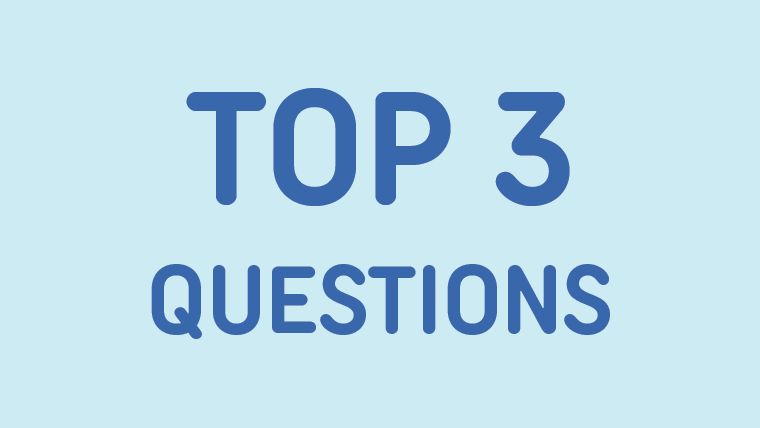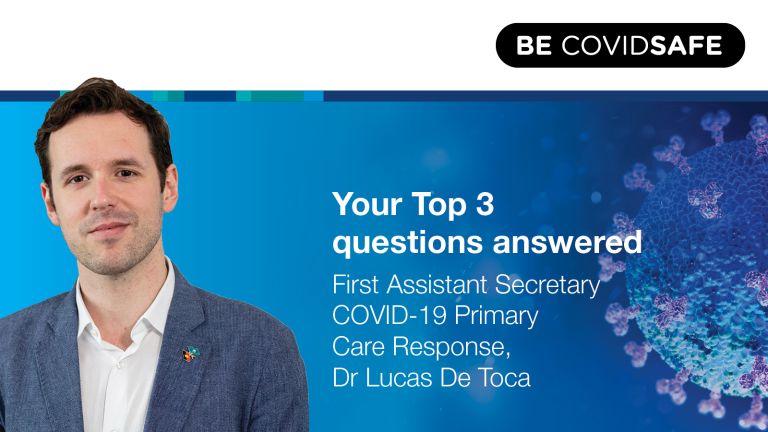
Hello. I’m Dr Lucas de Toca and we are filming today on Ngunnawal country. I lead the rollout of the vaccine through GPs, pharmacies and Aboriginal Health Services for the Australian Government. And today, we’re going to be answering three of your most frequently asked questions in our social media channels. We’re going to talk about fully vaccinated, and whether that status has changed. We’re going to talk about why some people get their infection from other people in their household and some people don’t. And we’re going to talk about vaccine adverse reactions.
So, the first question is, what is the definition of fully vaccinated and has it changed recently? We have been referring for people to be fully vaccinated as receiving two doses of COVID-19 vaccines. Two doses of the same, or different COVID-19 vaccines that are approved or recognised in Australia. Recently, the Australian Technical Advisory Group on Immunisation, or ATAGI, changed the definition and replace it with the term that we use now, which is up-to-date. And essentially its advice for people in Australia on how to stay up-to-date with their COVID-19 vaccination. That’s more similar to the terms that we use in other vaccine programs like in the ³Ô¹ÏÍøÕ¾ Immunisation Program. In order to stay up-to-date with your COVID-19 vaccine status, you need to have a number of doses over a period of time. So essentially, the major change is that they’ve included now a booster shot or for most people a third shot, as part of your up-to-date status. If you’ve had two doses of your COVID-19 vaccine, what we call the primary course and you’ve had them in the last three months, you’re fine, you’re up-to-date, you don’t have to do anything else. As you know, ATAGI recommends that you get a booster shot three months after your second dose. And what they’ve said now is that you are up-to-date three months after that. It sounds really complicated, but the crux of it is, you’re up-to-date with your vaccines, if it’s been six months from your second dose. You’re recommended to get your booster at three months, but as long as you get it within the six months from your second dose, you will maintain your up-to-date status. If it’s been more than six months after your second dose and you haven’t had a booster, then you’re no longer up-to-date with your COVID-19 vaccine status. You’re overdue. We’re going through a number of changes in the next few weeks for the COVID-19 digital certificates and other systems so that eventually people who are not up-to-date may not be able to download their COVID-19 digital certificate, but those changes will take some time so there’s plenty of opportunities for people to be up-to-date. At the moment, the majority of people who are currently eligible for a booster, so people who have had their second dose three or more months ago, are coming forward to get their booster shot. There’s more than 10 million people who have had a booster already and that includes over 80% of people 70 years and over which is really exciting. So the message is, get your booster when you’re due which is three months after your second dose and ensure that you stay up-to-date with your COVID-19 vaccinations. This has not changed the definition of fully vaccinated for international border purposes. So for the purposes of inbound travellers coming into Australia, that’s different to clinical advice in the country, people who have had two doses of a TGA-approved or recognised vaccine, or one dose of the Janssen or J&J vaccine can still come into the country.
We’re also going to talk today about why it seems like some people get it,get COVID-19 from their household members, and some people don’t, even if they have people in their house who are infected. And the reality is that transmission dynamics for any injection, not just for COVID, vary a lot. And there’s a lot of factors that impact on that. Generally, of course, if you’re sharing a household with someone with COVID-19, your risk of contracting COVID is very high. Things like recent vaccination, or being boosted, and of course the precautions that you take within the household, can have an impact to significantly reduce that risk, but ultimately, we can’t really predict whether someone will get infected or not. There’s a high chance, if you’re in the same household, that some people don’t get it. Individual health status, individual antibody production, whether you’ve had the infections previously or not, and of course, the recency of your booster, all play a role. But it is not a clear-cut thing where we can say “you will get” or “no you don’t.” And that’s why it’s so important that we all continue to practice all the precautions that we have been practicing over the last two years, and that we ensure that we stay up-to-date with our vaccine status, by getting a booster three months after our second dose.
Finally, what are vaccine adverse reactions, or vaccine adverse events? I mean, as the name indicates, any reaction or issue they have after a vaccine can be classed as an adverse event. The Therapeutic Goods Administration, or the TGA, is running an enormous program to monitor vaccine adverse events for the COVID-19 vaccines, which is actually much bigger, and of a bigger scope than we have for a previous vaccine, with any previous vaccine, because we want to make sure that we’re capturing all the information that we need. We’ve administered more than 50 million doses of COVID-19 vaccine, and only about 97,000 adverse events have been reported. So that’s about 2.3 for each thousand doses administered. The immense majority of adverse events are mild, are minor, and resolve very quickly after the dose, and are mostly local injection site adverse events, like a sore shoulder or sore arm after receiving the vaccine, or some short-lived systemic effects like fever, chills, having a headache or feeling just a little bit off the day after your vaccine. There’s a small number of very rare but severe adverse events, myocarditis or pericarditis, inflammation of the heart or the membrane around the heart, after mRNA vaccines, or the thrombosis of thrombocytopaenia for AstraZeneca vaccines, but these are extremely rare. But of course, it’s important adverse events continue to be monitored so we have the best information about how these vaccines are operating in our society. And it’s really reassuring, as I said, after 50 million doses, that we are seeing that, like, any medication, like any vaccine, these vaccines may have adverse effect, adverse events, but overall, they’re very safe.
That’s all for today. Thank you for listening, and thank you for staying COVID-safe.
Top 3 questions
- What is classified as fully vaccinated in Australia and why has this changed?
- Why are some people in the same household getting sick with COVID-19 while others don’t show any symptoms?
- What is classified as an adverse COVID-19 vaccine reaction?









